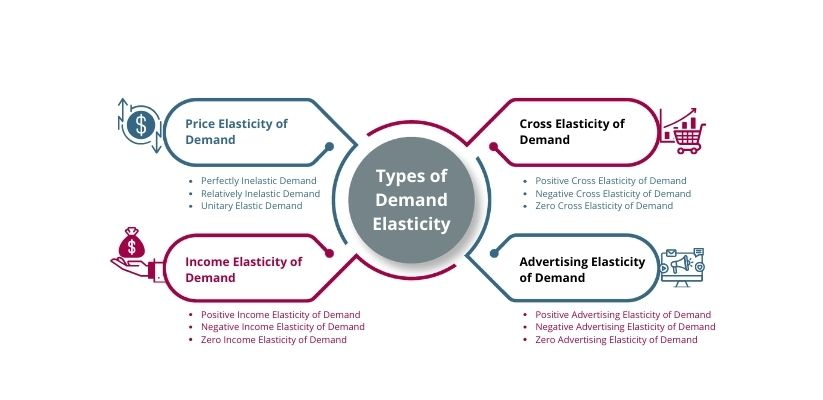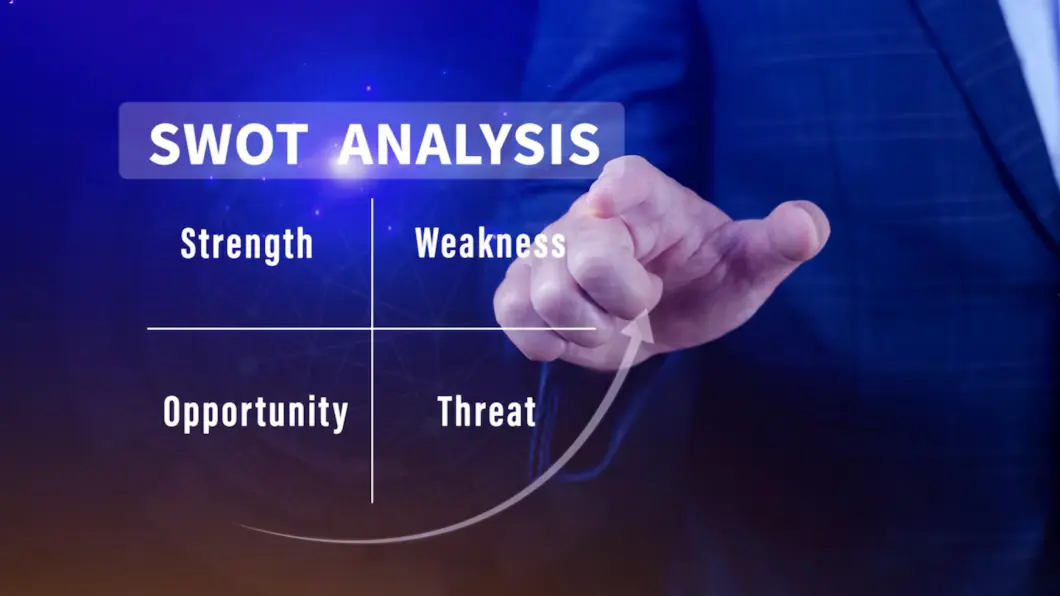Definition: The Elasticity of Demand (EOD) is the substantial change in demand for a product or service in response to an economic factor such as price, availability of substitutes, or change in income level. It indicates how the changes in various economic factors lead to a shift in demand.
What is Elasticity of Demand?
Elasticity of demand measures the possible changes in demand for a product or service in relation to factors like change in product price or customer income level, availability of competing products, the necessity to purchase and the impact of promotional activities.
When a company understands the impact of various factors on demand elasticity, it can skillfully decide on how to price, what products and features to include or remove, and make informed investment decisions to boost the return on investment.
A product is said to be elastic when the change in economic factors leads to a significant shift in demand. In contrast, a product is said to be inelastic when the demand remains unchanged despite changes in economic factors.
To know the elasticity of demand, businesses need to conduct market research or gain insights from research reports. Besides, they need to perform data analysis using tools like ERP software that enables statistical analysis of historical data, identifies demand patterns and helps perform what-if scenario analysis.
Which Factors Impact Elasticity of Demand?
Here are the different factors that can impact the Elasticity of Demand.
1. Level of Urgency
If the consumer perceives a product as urgent, he may likely purchase it regardless of the change in the price. For example, life-saving medicines are considered inelastic products. This is because consumers will not stop their consumption with changes in the price.
2. Availability of Substitutes
Let us take the example of two rivals in the beverage industry. In an example world, both Coca-Cola and Pepsi are available in the market, and people love both of them due to similar taste profiles. A sudden spike in the price of Coca-Cola will reduce its demand and increase the sales of Pepsi, and vice versa.
3. Personal Preferences
Customers are often loyal to certain brands. Such loyal customers are less likely to switch to substitutes despite an increase in the price of the product. For example: Users who perceive higher quality in Mac Books may not switch to other brands, despite an increase in the price of Mac Books.
4. Market Competition
The level of competition in the domestic market is another factor. Higher competition leads to lower brand loyalty and increased elasticity of demand. In contrast, lower competition leads to inelasticity as the consumers are left with little to no alternatives.
5. Availability of Information
With the advent of the Internet and smartphones, customers have access to a vast knowledge base of different products and services. With easy access to required information, they can make informed decisions. Customers who do not have easy access to such information may contribute to a lower elasticity of demand.
How to Calculate Elasticity of Demand?
The Elasticity of Demand is calculated by dividing the change in quantities (percentage) by the change in price (percentage) or any other economic factor. If the quotient is equal to or higher than 1, it indicates elastic demand. In contrast, if a quotient is less than 1, it indicates inelastic demand.
Formula to Calculate Elasticity of Demand:
Let’s take an example: Products such as jewelry, perfumes, high-end clothing, and premier watches, are considered luxury items. As these products are not essential for sustaining human life, an increase in their price leads to a sudden drop in sales as consumers look for lower-priced alternatives or delay their purchases.
Elasticity of Demand Example
During the year-end sale, when a car dealership offers 5% discount on the sale price of a car model to clear excess inventory, they observe that demand for that model rises by 10%. The elasticity of demand for the car can be calculated as follows.
Elasticity of demand = 0.10 / 0.05 = 2. Therefore, the car sales are sensitive to price changes. In other words, the demand for cars is elastic.
Four Types of Demand Elasticity
The four types of demand elasticity are price elasticity of demand, cross elasticity of demand, income elasticity of demand, and advertising elasticity of demand. These types help in understanding how the demand for a product varies based on different factors under consideration.
1. Price Elasticity of Demand
The Price Elasticity of Demand indicates a higher sensitivity in demand concerning the changes in the price. For example: A change in the price of the product or service leads to customers switching to other substitutes or alternatives available.
Price Elasticity of Demand formula = Per cent change in demand quantity / Per cent change in price
Types of Price Elasticity of Demand
There are three types of Price Elasticity of Demand:
- Perfectly Inelastic Demand: This is an economic condition in which changes in price and other factors don’t lead to changes in demand.
- Relatively Inelastic Demand: This is an economic condition in which only a significant change in the price or other factors leads to a change in demand.
- Unitary Elasticity: Unitary Elasticity (also called Unitary Elastic Demand) is one of the types of Price Elasticity of Demand in which the price and economic factors have an equal impact on demand.
2. Cross Elasticity of Demand
The Cross Elasticity of Demand defines the correlation between the changes in the price of one commodity and its effect on the demand for another commodity. For example, tea and coffee are substitutes for each other. An increase in the price of coffee may trigger an increase in the demand for tea, and vice versa. It does not consider unrelated products.
Here’s the formula to calculate the Cross Elasticity of Demand:
Types of Cross Elasticity of Demand
There are three types of Cross Elasticity of Demand:
- Positive cross: Positive Cross Elasticity of Demand is an economic condition in which an increase in the price of one product, results in a proportional increase in the demand for another product.
- Negative Cross: Negative Cross Elasticity of Demand is a condition in which an increase in the price of one product, results in a proportional decrease in the demand for a complementary product.
- Zero Cross: Zero Cross Elasticity of Demand is an economic condition in which a change in the price of one product does not affect the demand for another product.
3. Income Elasticity of Demand (Economic Elasticity)
The Income Elasticity of Demand (also known as Economic Elasticity) defines the correlation between the customer’s income and the demand for the product. Let us take an example of Income Elasticity of Demand: When the income level of the customers changes, it impacts the demand for Product “A” while price & other factors remain intact.
Here’s the formula to calculate the Income Elasticity of Demand (Economic Elasticity):
Types of Income Elasticity of Demand
There are three types of Income Elasticity of Demand:
- Positive Income Elasticity of Demand: In this economic condition, the demand for a commodity increases with the increase in the customer’s income and reduces with the decline in the household income.
- Negative Income Elasticity of Demand: In this economic condition, the demand for a commodity increases with the decrease in the customer’s income and reduces with the rise in the household income.
- Zero Income Elasticity of Demand: In this economic condition, a change in the household income does not result in a change in the demand for the commodity.
4. Advertising Elasticity of Demand
The Advertising Elasticity of Demand defines the impact of the company’s advertising on its sales. It analyzes the correlation between the advertising campaigns and the demand for the product or service. Typically, Advertising Elasticity is not considered an accurate method because it ignores many important factors such as the customer’s interests and spending habits.
Here’s the formula to calculate the Advertising Elasticity of Demand:
Types of Advertising Elasticity of Demand
There are three types of Advertising Elasticity of Demand:
- Positive Advertising Elasticity of Demand: This is an economic condition in which an increase in advertising spending results in a proportional increase in the demand for the product, and vice versa.
- Negative Advertising Elasticity of Demand: This is an economic condition in which an increase in advertising spending results in a drop in the demand for the product, and vice versa.
- Zero Advertising Elasticity of Demand: This is an economic condition in which advertising spending neither yields positive results nor drops in the demand for the product.
Difference Between Elastic & Inelastic Demand
Elastic Demand and Inelastic Demand are two commonly used terms in the Elasticity of Demand. Now, let us understand the difference between the two.
| Aspect | Elastic Demand | Inelastic Demand |
| Definition | A demand is said to be elastic when the change in the price of a product leads to a significant change in its demand. | A demand is said to be inelastic when the change in the price of a product leads to little or no change in its demand. |
| Price Sensitivity | Higher | Lesser |
| Availability of Substitutes | Readily Available | Mostly Unavailable |
| Type of Curve | Shallow | Steep |
| Direction | Opposite Direction | Same Direction |
| Elasticity Coefficient | Higher than 1 | Smaller than 1 |
| Example Products | Jewelry, perfumes, high-end clothing, and premier watches | Milk, life-saving drugs, and oxygen cylinders |
Benefits of Measuring Elasticity of Demand
1. Demand Forecasting
Calculating the Elasticity of Demand helps businesses forecast sales and get insights into upcoming revenue streams so that they can cover their operational costs, and make regular payments to suppliers and other stakeholders.
2. Resource Allocation
Another benefit of measuring elasticity is that you will be in a better position to predict demand, plan manufacturing activities, and boost turnover. This way, you can reduce under-staffing and over-staffing, and save costs in the long run.
3. Efficient Pricing Strategies
Getting insights into the potential sales and revenues allows businesses to draft efficient pricing strategies. The management can make informed decisions about the pricing of the existing products, and the launching of new products.
4. Investment Decisions
Right investment decisions are complex and irreversible. They are crucial for an organization’s growth and success. The Elasticity of Demand enables businesses to build a financial roadmap and make informed investment decisions to expand into new markets and yield higher returns.
5. Market Segmentation
The Elasticity of Demand makes it easier to segment the market and tailor different pricing strategies for different customers. For example: Companies can charge different amounts for the same product to different customers based on their price sensitivity.
Limitations of Measuring Elasticity of Demand
1. Unrealistic Assumptions
During the calculation of Elasticity of Demand, it is assumed that only the price changes and other factors remain intact. These assumptions are not realistic in a real-world scenario where consumer preferences, income levels, and availability of substitutes change from time to time.
2. Diversity Across Markets
Oftentimes, markets are diverse. There are demographic differences across the same market. When the consumer interests and income levels differ across the same market, it gives a limited predictive capability.
3. Duration of Time
Elasticity can be classified by the nature of the duration — short-run elasticity and long-run elasticity. Changes in different factors such as market trends, consumer interests, and availability of substitutes, can cause the elasticity to differ.
4. Complex Interpretations
At times, while calculating the elasticity, the values can be close to zero. Interpreting elasticity in such scenarios becomes difficult. Human errors during interpretations can cause erroneous assumptions while making business decisions.
5. Assumption of Linear Relationship
The formula of Elasticity of Demand assumes that there is a linear relationship between the price and quantity. However, in a practical scenario, the demand curves need not be linear at all times. This is especially true for luxury products such as jewelry, premier watches, and real estate.
How ERP Software Helps with Measuring Elasticity
Enterprise Resource Planning (ERP) is a business planning and management tool that contains a multitude of modules that automate various core processes from production, project management, supply chain, and human resources, to financial management. It provides detailed insights and reports so that decision-makers can reduce costs, maximize profits, and make timely & informed decisions.
1. Compare Historical Sales
An ERP comes with powerful statistical algorithms, Machine Learning, and business intelligence tools that analyze historical sales and compare them through the identification of trends and demand patterns.
2. Identify Demand Patterns
ERP performs data-driven analysis to identify demand patterns based on the current market conditions. It can accurately predict demand. Businesses can bring efficiency to the supply chain process through supply chain management in ERP.
3. Meet Future Demand
ERP benefits businesses in various ways from predicting demand for products to building a highly efficient inventory management system. With ERP, businesses can reduce the instances of over-stocking and under-stocking, and pave the way for expansion into new markets.
4. What-if Analysis
Another key benefit of using an EPR is its ability to evaluate the impact of future decisions through the powerful scenario planning and What-if Analysis features. These features play a critical role in understanding how to respond to changes and predict risks even before making decisions.
5. Customizable Reporting
ERP converts large, complex data into easy-to-interpret reports through intuitive charts, reports, and customizable dashboards. Businesses can use the various performance metrics and better respond to changes.
Conclusion
The Elasticity of Demand enables businesses to understand whether products are very responsive, less responsive, or not responsive to the change in price and other economic factors. Calculating the Elasticity of Demand using ERP Software can enable businesses to forecast demand for their products, and draft efficient product pricing strategies to drive growth and maximize their profits.
Sage X3 is a business-critical solution that streamlines the process of data capture and big data analysis. Your business can use its powerful forecasting capabilities to identify seasonal trends, consumer preferences, and economic conditions, and stay ahead of the competitors through real-time data capture, visualization, and intuitive charts & reports.
Elasticity Of Demand FAQs
1. What is the Definition of Price Elasticity of Demand?
The elasticity of demand meaning a proportional change in the demand for a product or service in proportion to the change in external factors such as the price of the product, availability of substitutes, and market trends, among others.
2. How to Measure Elasticity of Demand?
The Elasticity of Demand is measured by dividing the demand changed by the change in the price. However, the exact method of measuring it depends on the type of elasticity. Each type of elasticity has a different calculation formula.
3. What is the Usage of Measuring Price Elasticity of Demand?
Measuring the Price Elasticity of Demand helps businesses in various ways. It helps them understand the price sensitivity of their products. They can form effective pricing strategies, and make informed decisions about the manufacturing of products. Besides, it helps Governments raise revenue through appropriate taxation strategies.
4. What Makes A Product Elastic?
A product is referred to as elastic when its demand changes significantly as a result of influencing factors like product price, customer income level, or availability of substitute products.
5. What Makes a Product Inelastic?
When the increase in the price of a product or service leads to little or no change in its demand, it is termed an inelastic product. Lack of availability of substitutes, lack of availability of quality substitutes, and brand loyalty, can make a product inelastic. Examples include milk, life-saving drugs, and oxygen cylinders.
6. What Does Elasticity of 1 Signify?
An elasticity of 1 signifies a one-for-one change in the demand in proportion to the price of the product. For example, a 20% reduction in the price of a product leads to a 20% increase in demand, and vice versa.












